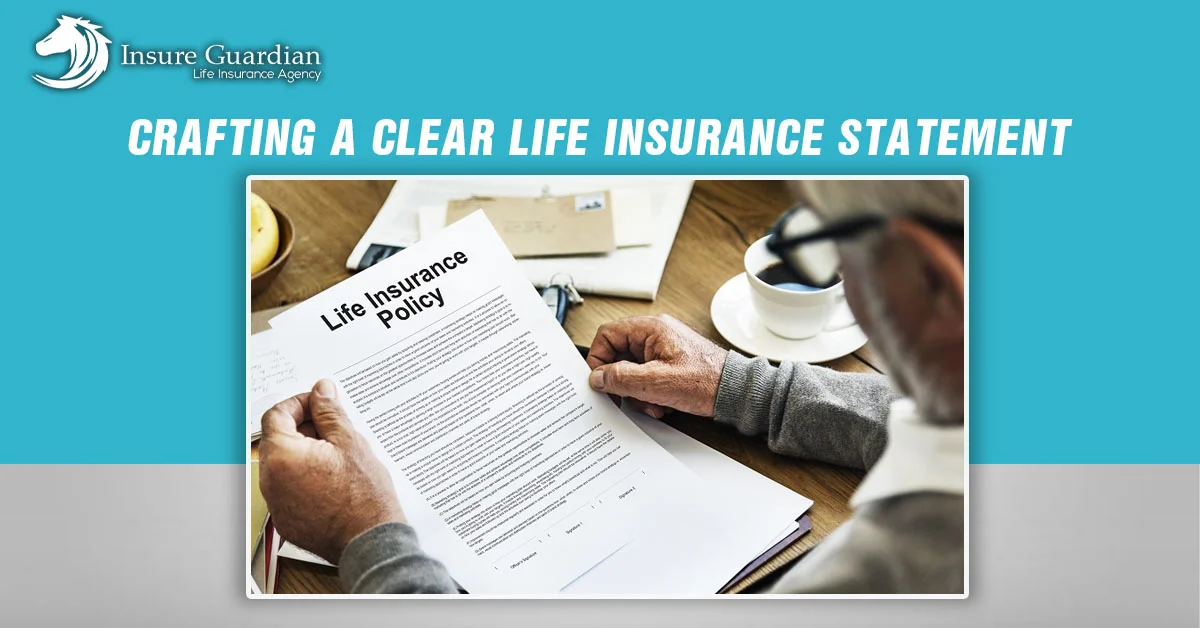A complete guide to life insurance statement
At first glance, life insurance(whole and term life) may appear scary. This is because the life insurance industry contains a lot of specialist jargon that isn’t always obvious to regular folks who don’t work with life insurance daily. That being said, with a bit of perseverance and the help of this article, you will be able to read and comprehend your complete life insurance statement.
Life insurance companies are bound by law to give policyholders an annual accounting of their policy once a year. This must be delivered to the policyholder within a particular interval around the policy anniversary date (usually 30 days before or after).
You can view the life insurance statement form here in a PDF
- Life insurance (both whole and term) statements typically include information regarding the five items listed below:
- The Death Benefit
- Cash Value Preferences
- Premium details
- Loans
- Dividend payments (if the policy is dividend-paying)
Death Benefit for Life
A life insurance statement’s death benefit information frequently includes multiple values. These are some examples:
- The standard whole-life death benefit
- A term rider’s death benefit is any death benefit provided by the rider.
- The death benefit is derived from paid-up additions.
The original death benefit from the life policy is the base exclusive life death benefit. It does not include any riders or death benefits from paid-up additions. This death benefit sum will not alter over time; it is the policy’s original guaranteed death benefit.
Any death benefit on the policy produced by including a rider that adds death benefit to the life insurance is referred to as a term rider death benefit. Depending on the insurance carrier, these riders might take a variety of forms. This rider is also the foundation for “blending” throughout one’s life.
Paid-up additions death benefit is a death benefit that is generated by either the elective paid-up additions rider or the dividend option to purchase paid-up additions.
Here’s an example of a policy statement that includes a breakdown of the death benefit:
A term rider death benefit is any death benefit on a policy established by the insertion of a rider that adds a death benefit to whole life insurance. These riders can take a variety of forms, depending on the life insurance company. This rider also serves as the foundation for “blending” one’s life.
Paid-up additions death benefit is generated by the paid-up additions rider or the dividend option to purchase paid-up additions.
In some complete life statements, the death benefit and face amount are reported separately. This can lead to some misunderstandings.
Here’s an illustration:
The insurance companies report the original face amount of the whole life and term death benefits, followed by an aggregate value for the entire base life, term, and paid-up additional death benefits. Some people may be perplexed by this reporting, and insurers may differ in how they disclose it.
Lifetime Cash Value
Absolute life cash values are often divided into guaranteed base cash value and paid-up additions cash value.
Looking back at the previous example, we can see a thorough breakdown of the policy’s cash value:
The base cash value of the policy is $10,000. The cash value is related to the base whole-life policy with a death benefit of $375,000. The remaining cash value in the procedure is derived from paid-up additions. This applies to both the paid-up additions rider and the dividend option to purchase paid-up additions.
The “guaranteed cash value” is used by some life insurance companies to refer to the base whole life cash value. This is an arcane term because any cash value currently in a real-life policy is guaranteed. This is most likely a relic of older systems and reporting processes. If you notice this, don’t be alarmed; all of the cash value you achieve with a whole-life policy is guaranteed cash value.
Premiums for Life Insurance
The premiums linked with the coverage are often broken down in the annual statement. This may or may not include the precise amounts paid to each compensation, as well as the discretionary paid-up extra rider. However, it will usually mention the policy’s payout frequency. Here’s an example from the same procedure we’ve been discussing:
The scheduled premium, which comprises the base life insurance premium and the term rider premium, is $6,000. In the last year, paid-up additions totaled $14,000. Therefore, this company does not include paid-up additions in the planned premium payments section since they are not deemed “scheduled.”
Loan Transactions
The annual insurance statement will include information about any outstanding loan activity. In addition, this will generally report the current loan balance and any loan interest payable at the policy anniversary. Here’s an example from a different policy involving a pending loan:
We can see that the client has a loan balance of $3,180.26 and that the loan interest is $235.57. The policyholder has the option of paying the $235.57 or adding the appeal to the loan total. Typically, the corporation will deliver a separate document to the client around the same time that explains the loan and the interest-due choice.
Some of these notices can be a little perplexing, leading the policyholder to believe that the policy is about to expire. I’m not sure why insurance companies do this, but if you get one, don’t panic. Your approach is probably satisfactory, and a quick call to the insurance company or your agent can check this.
Dividend Income
If the whole-life policy is dividend-eligible, the yearly statement will generally include information on the dividend received and chosen dividend option. Here’s an example from the previous policy we discussed:
Income from Dividends
If the life policy is dividend-eligible, the yearly statement will typically include information on the dividend received as well as the dividend option selected. Here’s an example from the previous policy we talked about:
The policy produced $3,000 in dividends, and that $3,000 was used to purchase paid-up additions. This added $15,000 to the policy owner’s death payout. The statement explains this, but it also means that the whole life policy now has an additional $3,000 in cash value.
Please note that the statement of life insurance also highlights the policy owner’s right to change his dividend option and educates him on how to do so.
Dividends might occasionally cause policyholders to become confused because they wish to reconcile the dividend payment to ensure the life insurance firm performed the arithmetic correctly. Unfortunately, there is no way to do this because the insurance company’s dividend computation is secret.
The general rule of thumb is to subtract the guaranteed reserve value from the dividend interest rate (provided the company publicly reveals it) and then apply the difference as a percentage to the policy’s cash value. This should result in a product close to the dividend payment, but it is not an exact figure. Furthermore, various variables can affect the dividend payout, resulting in a bigger or smaller dividend than this computation provides.
What do you mean by Policy Riders in Life Insurance?
When it comes to comprehending your life insurance statement, it’s essential to familiarize yourself with the concept of policy riders. Policy riders are additional features that can be attached to your life insurance policy to customize it according to your specific needs. These riders can have a significant impact on the death benefit and other aspects of your policy.
Some common policy riders you might encounter in your life insurance statement include:
Accidental Death Benefit Rider: This rider provides an extra payout in case the policyholder dies due to an accident. It can be a valuable addition if you have a risky occupation or engage in high-risk activities.
Waiver of Premium Rider: With this rider, if you become disabled and are unable to pay your premiums, the insurance company waives your premium payments while keeping your policy in force.
Long-Term Care Rider: This rider allows you to access a portion of your death benefit to cover long-term care expenses if you require it. It can be a financial safety net in your retirement years.
Understanding these policy riders and how they affect your life insurance coverage is crucial for a complete grasp of your life insurance statement.
Evaluating the Performance of Your Life Insurance Investment
Your life insurance policy can also serve as an investment vehicle. It’s important to evaluate the performance of your life insurance as an investment to ensure it aligns with your financial goals. Here are some key points to consider when assessing your policy’s performance:
Cash Value Growth
Examine how your policy’s cash value has grown over time. Is it meeting your expectations? You can use the cash value for loans, withdrawals, or to enhance your policy’s death benefit.
Dividend Income
If your policy is eligible for dividends, evaluate the dividend payments and their impact on your policy’s cash value and death benefit. Are dividends helping your policy grow as expected?
Premium Payments
Review your premium payments and ensure they are affordable and fit your budget. Adjustments may be needed if your financial circumstances change.
Coverage Adequacy
Reassess whether your policy’s death benefit still adequately covers your family’s financial needs. Life events like marriage, the birth of children, or a change in income may necessitate adjustments.
Tax Benefits
Consider the tax advantages of your life insurance policy, such as tax-free death benefits and potential tax-deferred cash value growth.
By regularly evaluating these aspects of your life insurance as an investment, you can make informed decisions to ensure it continues to meet your long-term financial objectives.







